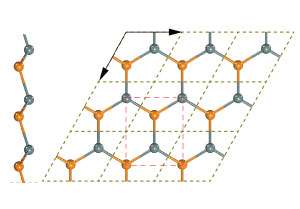Electrons play a key role in heat transport through 2-D tin sheets

Heat travels through atom-thin sheets of tin in a very unusual way, A*STAR researchers have found. The discovery could help develop applications for the material, including thermoelectric refrigeration or power generation.
Graphene, a layer of carbon just one atom thick, was first isolated in 2004. Since then, researchers have created a plethora of other '2-D' analogs of graphene using different atoms. Stanene, with its tin atoms arranged in a slightly corrugated hexagonal pattern (see image), arrived in 2015. Hangbo Zhou and colleagues at the A*STAR Institute of High Performance Computing have now studied how this cousin of graphene conducts heat.
In solid materials, heat is generally carried by electrons or through vibrations between atoms. As these vibrations travel through the material, they behave rather like a particle, known as a phonon. At room temperature, graphene mostly conducts heat with phonons, whereas metals largely rely on electrons. But in stanene, the balance between these two mechanisms was unknown.
The A*STAR team calculated the phonon and electron thermal conduction in stanene at various temperatures, and found that stanene has a much lower phonon thermal conduction than graphene. Indeed, at room temperature, electron thermal conduction in stanene is roughly the same as its phonon conduction.
They also found that stanene deviates from the Wiedemann-Franz law, which states that electron thermal conduction depends on the temperature and the electrical conductivity of the material. In stanene, however, the contribution of electron thermal conduction to overall heat transfer also depends on the material's 'chemical potential'— a measure of how much energy is required to add one more electron to the material. Crucially, the researchers found that chemical potential also affects electron thermal transport in graphene and some other 2-D materials.
The surprising findings could make stanene useful in thermoelectric devices, in which a temperature gradient creates a voltage between two parts of a material, or vice versa.
"The Wiedemann-Franz law is one of the major factors that limits the thermoelectric efficiency of conductors," says Zhou. "The violation of the law may provide an alternative route to achieving high-efficiency thermoelectric materials."
The calculations suggest that stanene's thermal transport properties could be tuned by altering its chemical potential, he adds, for example by adding traces of other atoms.
The team now hopes to calculate how efficiently stanene can generate thermoelectric power, and the size of the voltage generated by a temperature difference in the material.
More information: Hangbo Zhou et al. Quantum thermal transport in stanene, Physical Review B (2016). DOI: 10.1103/PhysRevB.94.045423
Journal information: Physical Review B




















